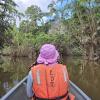As promised, here is the Galapagos “day in the life” post, where I chronicle a typical day studying abroad on Isla San Cristóbal. Hopefully, this gives you a clearer idea of what to expect if you choose to study here.
An important note: some of the information in this post is specific to the Quito Summer - Environmental Studies program. Full-semester and direct-enrollment programs will look a little different than this.
Also, if you haven’t seen the “day in the life” post I did while living in Quito, you can find that here.
And now, without further ado, A Day in the Life: Galapagos Edition…
7:15 A.M. – wake up
A whole 30 minutes later than in Quito. Yippee!
7:30 A.M.– breakfast
Then I come down for breakfast with my host family, which for me usually consists of eggs, pancakes or fried plantains, and a bowl of fruit. Of course, the meal is accompanied by a glass of juice – even on the islands, juice is a staple menu item in Ecuador. While we eat, I let my host parents know roughly what my plans are for the day.
8:40 A.M. – walk to USFQ, stop at lockers
After packing up both my school supplies and swimming/snorkeling gear, I head over to school. San Cristóbal is much quieter than Quito, and I feel safe having my phone out if I need to check for directions. I still stay aware of my surroundings though, especially when I’m using my phone.
It’s typically a 15 minute walk to the university, but I give myself extra time to stop at my locker and drop off my swimming stuff. There are lockers both inside the building and in the quad outside. I picked an outside locker because of its proximity to both my classroom and the swimsuit rinsing station.
9:00 A.M. – class
Then comes the environmental policy class. Usually, the professor spends about half the class period lecturing, and the other half leading a group discussion about the assigned reading. As a music major, I wasn’t really used to reading scientific studies, but I’ve gotten better at it since starting this course.
12 (noon) P.M. – lunch
Depending on which beach we plan to visit that afternoon, my classmates and I either get a sit-down lunch from one of the restaurants in town or get a to-go lunch. For sit-down lunches, I usually either get a cheap almuerzo from someplace with a chalkboard menu, a $1.50 empanada from the café at Universidad San Francisco de Quito (USFQ), or fork out for a dinner menu item at Post Office restaurant on the boardwalk. For to-go lunches, I usually purchase a sandwich or cheesy bread (quesadilla) from Kachi Tanta at four corners and an apple from a nearby market.
1:00 P.M. – pick a beach
After grabbing lunch, my classmates and I head to the beach. Below, I’ve listed our go-to beaches in order of convenience:
Playa Mann
This is the beach right outside USFQ. It is the most developed of all the beaches, with a restaurant, snack bars, restrooms, and a lifeguard on duty. There are usually tons of people and sea lions here, so this is more of a come-to-relax beach rather than a swimming/snorkeling beach.
Its accessibility from USFQ makes this the ideal beach for days when you have homework to do. On Playa Mann days, I typically buy an ice cream from the snack bar and chill on the beach for a bit, then go back to USFQ to work. Sometimes, my classmates and I play board games on the USFQ balcony, then come down to Playa Mann afterwards.
Punta Carola
Punta Carola is the second closest beach to USFQ; it’s about 10-15 minutes north of the university. There are two ways to get to Punta Carola. The most direct route follows the dirt road that the trucks use to get to the loading dock. The other route is a paved hiking trail, which starts at the interpretive center. The second way is slightly longer, but nicer also, since you’re not dodging semi-trucks or inhaling the dust that they kick up.
This beach is not very developed – there are posts for hanging your belongings, but that’s it. The nearest washrooms are back at the interpretive center.
Punta Carola is a sandy beach with rocks on the sides. There is a big, sheltered patch of ocean that is good for swimming and snorkeling. There isn’t a huge variety of fish to see, but there are quite a few turtles and marine iguanas. There are also sea lions, so make sure to be aware of your surroundings and keep a safe distance from them.
Punta Carola also has a lighthouse at one corner. The walk to the lighthouse goes through a lot of lava rocks, so shoes are recommended but not required – it’s not the sharp kind of lava. You can usually find marine iguanas, pelicans, and frigate birds near the lighthouse. Once, I saw a blue-footed booby sitting on the rocks, preening (pictures below, of course).
Darwin Bay (Las Tijeretas)
Darwin Bay is slightly farther north than Punta Carola. To get there, start at the interpretive center and take the same trail that leads to Punta Carola, but skip the first turn off. It’s about 15-20 minutes from the university. The nearest washroom is back at the interpretive center.
Unlike the sandy beaches previously discussed, Darwin Bay is a sheltered bay enclosed by cliffs and lava rocks. There is a wooden platform close to the water where you can sit and relax, but it’s pretty small and can get crowded in the afternoons.
Most people use the platform as a place to leave their stuff while they go snorkeling. Darwin Bay has the best variety of marine life of all the beaches in this list. You can always see the big three: sea lions, turtles, and iguanas – this bay is actually a prime spot to see marine iguanas feeding underwater! There are also many different kinds of fishes and invertebrates – starfish, three species of sea urchin, sea slugs, king angelfish, blue-barred parrotfish, harlequin wrasse, and pacific creolefish, to name a few.
The downside of Darwin Bay is that the water is really cold. I can snorkel for around 45 minutes without a wetsuit, then I have to get out and warm up. Generally, this isn’t a beach where you can snorkel multiple times in an afternoon. After one go, you’ll want to walk back to campus to buy a hot drink. (Note: I was here in July, during the cold season. Your experience may be different if you’re here during the warm/rainy season.)
Playa Lobería
Playa Lobería is significantly farther away from campus than the first three beaches – about a 40 minute walk. My classmates and I have gone here on weekends, but we’ve also come here after class for a couple hours.
Lobería is the kind of beach you can spend all day at. There is a small snack bar at the parking lot where you can use the restroom for 25 cents. After that, there’s a sandy trail that leads to the beach. I couldn’t tell you how long the walk is because I always stop to take pictures of iguanas, lava lizards, and the bright-colored shrubs along the path.
Like Punta Carola, Playa Lobería is a sandy beach with rocks on both sides. The rocks on the right side are off-limits – that’s sea lion territory. Going there can stress out the sea lions and make them more likely to bite people. The rocks on the left, however, are fair game. There’s even a walking trail behind them that leads to cliffs where you can see marine iguanas, seabirds in flight, and nesting swallow-tailed gulls.
Between the rocks is a great spot to swim and snorkel. A line of buoys marks the boundary of the safe-to-swim area, so you can easily know if you’re in the right place. Of these beaches, Playa Lobería is probably my favorite place to snorkel. There may not be as much to see as at Darwin Bay, but the water is shallower and warmer, so you can stay in for longer (and something about being able to touch the bottom if needed puts my mind at ease). There’s usually a huge school of blue-barred parrotfish in the rocky areas near the shore. There is also a sea turtle cleaning station close to the buoys. Some other highlights from my snorkeling trips to Playa Lobería include hieroglyphic hawkfish, spinster wrasse, and a cornetfish (Google it! They look super cool and weird).
Puerto Chino
Puerto Chino is on the opposite side of the island from USFQ and is only accessible by car. A taxi ride there is about $40-50 one way. As a result, this is more of a “whole day beach.” On one of our free days, my classmates and I got a ride there and back from one of our host families – we still paid for gas money, but it was about half the cost of a taxi ride.
Puerto Chino is not very developed. There is a paved trail from the parking lot to the beach, and a couple of picnic tables, but that’s it. The nearest washroom is at the Galapaguera, which is at least 40 minutes away on foot. So plan to either go in the ocean, or bring a backpacking bathroom: Kleenex/toilet paper, a Ziploc for used paper, and hand sanitizer.
Puerto Chino has the best sand of the beaches in this list. It feels like the kinetic/sensory sand from preschool – it’s soooo soft. The downside is, it gets everywhere. You will have to shake out your swimsuit and towel a lot, and if they don’t completely dry before you leave, you will be bringing sand home. Bring a plastic bag to carry sandy clothes/towels (so you don’t drop sand all over your floor).
This beach isn’t a snorkeling beach, but it’s the best “play around in the waves” beach. You still may want to bring your snorkel mask to keep the saltwater out of your eyes. There is also a rocky hill you can hike up with gorgeous views. Additionally, the rocks at the base of the hill have some interesting wildlife. I spent probably 30 minutes watching a striated heron hunt for crabs among the rocks.
5:30ish P.M. - return to USFQ
After going to the beach, I typically go back to the university to change into dry clothes and retrieve stuff from my locker. Sometimes I use the swimsuit rinsing station in the quad, but usually I just rinse my swimsuit at home. At around 6pm, I often walk to Playa Mann to watch the sunset.
6:30 P.M. – walk home
After a long afternoon at the beach, it’s time to head home. I usually take the scenic route along the boardwalk, then turn onto Ave. 12 de Febrero. I often get to see nocturnal herons waking up during my evening walk. Other times, I see turtles. Once, I encountered a military parade – I ended up staying out late to listen to the marching band.
Once I get home, I take a quick shower and rinse the salt out of my swimsuit. With the humidity, it takes at least a full day for a swimsuit to (mostly) dry, so I use two swimsuits on rotation.
7:30 P.M. - dinner
Dinner at my host home usually consists of some kind of meat (usually chicken or fish), half a plate of rice, and a small salad. After eating, I usually stay downstairs and watch the news with my host family. Eventually, my brain gets too tired to think in Spanish, so I excuse myself to my room.
8:30 P.M. – homework or free time
I typically use this time to complete the reading assignment for the next day’s class. After that, I do my daily photo uploads, message my friends and family back home, and relax.
10:30 P.M. – sleep
And with that, the day is over. I’m usually thoroughly exhausted at this point, and fall asleep before my head hits the pillow.
***
Photo Gallery
Here are some of the photos I’ve taken during my stay in the Galapagos:
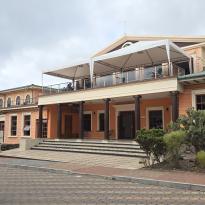
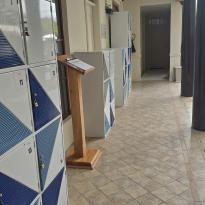
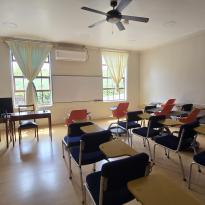
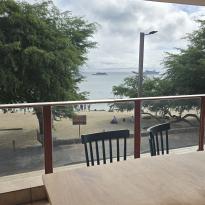
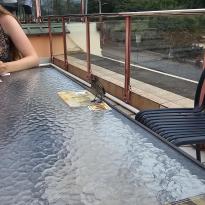

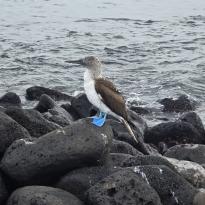
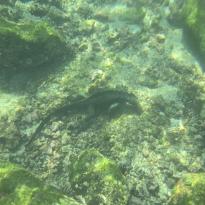
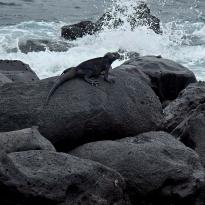
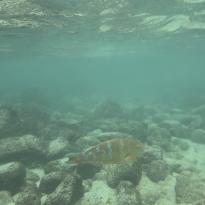
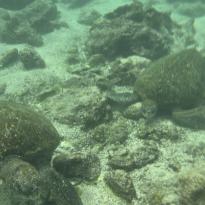
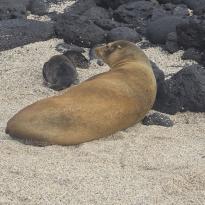
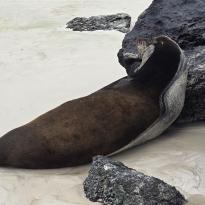
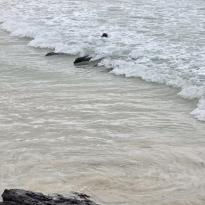


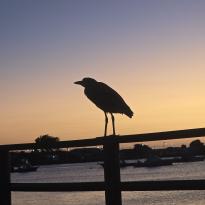
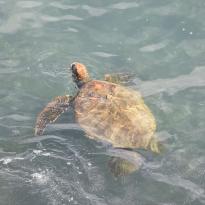
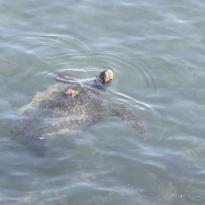
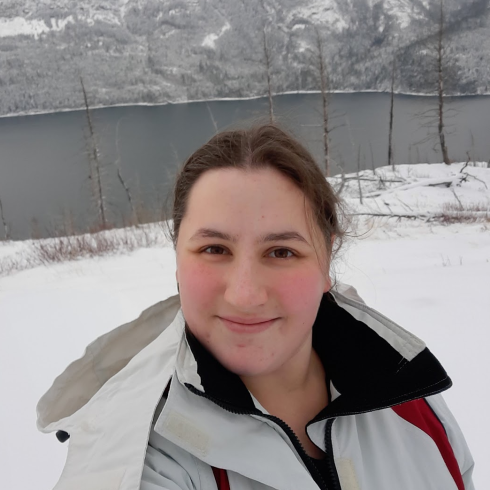
Teagan Serink
Salutations! My name is Teagan Serink. I’m a junior at the University of North Texas, where I’m studying music, technical communication, and Spanish. I enjoy singing, birdwatching, and herping. This summer, I’ll be studying ecology in Quito, Ecuador!























